I have previously done the Coursera Machine Learning exercises in Matlab. I thought, now that I am starting to get away from Matlab and use Python more, I should re-do the exercises in Python. This is exercise 1.
%matplotlib inline
import matplotlib.pyplot as plt
import numpy as np
import scipy
Part 1: Create an eye matrix. While this is incredibly simple, I want to make sure that I go through each step and provide a resulting document that a novice can follow long and understand what is happening.
A = np.identity(5)
print A
Part 2: Read in the data from ‘ex1data1.txt’ and plot it as a scatter plot
# Use the numpy genfromtext function to read the data
data = np.genfromtxt('/Users/matthewturner/Desktop/Coursera_machine_learning/'+
'machine-learning-ex1/ex1/ex1data1.txt', delimiter=',')
# Pull out the first column (theta0) into the variable X, and the 2nd column (theta1)
# into the variable y. These variable names are consistent with the example.
X,y = data[:,0],data[:,1]
# Set m = the length of y (i.e., the number of observations).
m = len(y)
y = y.reshape(m,1)
plt.scatter(X,y)
Part 3: Gradient Descent
# Add a column of ones to the data
X = np.c_[np.ones((m,1)),X]
theta = np.zeros((2,1))
iterations = 1500
alpha = 0.01
def costFuncIter(X,y,theta):
cum_sum = 0
for i in range(m):
h = np.dot(X[i],theta) - y[i]
cum_sum += 1.0/(2*m) * h * h
return cum_sum
J = costFuncIter(X,y,theta)
print J
# Compute and display the initial cost function
def costFunc(X,y,theta):
h = np.dot(X,theta)-y
h2 = np.dot(h.T,h)
J = 1./(2*m) * h2
return J[0,0]
J = costFunc(X,y,theta)
print J
# Run the Gradient Descent Algorithm
def gradientDescent(X,y,theta,alpha,iterations):
J_history = np.zeros(iterations)
for iter in range(iterations):
h = np.dot(X,theta) - y
h_X = np.dot(X.T,h)
temp = theta
temp -= alpha / m * h_X
theta = temp
J_history[iter] = costFunc(X,y,theta)
return theta,J_history
theta, J_history = gradientDescent(X,y,theta,alpha,iterations)
print theta
# Plot the timeseries of cost function
plt.plot(J_history)
# Plot the observations and the best fit line that we just solved for
plt.scatter(X[:,1],y)
plt.plot(X[:,1],np.dot(X,theta))
# Make the 2 predictions
predict1 = np.array([1,3.5]).dot(theta)
predict2 = np.array([1,7]).dot(theta)
print predict1
print predict2
Part 3: Now we do the multi variable exercise
# Use the numpy genfromtext function to read the data
data2 = np.genfromtxt('/Users/matthewturner/Desktop/Coursera_machine_learning/'+
'machine-learning-ex1/ex1/ex1data2.txt', delimiter=',')
# Pull out the first column (theta0) into the variable X, and the 2nd column (theta1)
# into the variable y. These variable names are consistent with the example.
X2,y2 = data2[:,0:2],data2[:,2]
# Set m = the length of y (i.e., the number of observations).
m2 = len(y2)
y2 = y2.reshape(m2,1)
Part 3.1: Feature Normalization
def featureNormalize(X):
mu = np.mean(X,axis=0)
sigma = np.std(X,axis=0)
X_norm = ( X - mu ) / sigma
return X_norm, mu, sigma
X_norm, mu, sigma = featureNormalize(X2)
# Add the column of ones to X2
X2 = np.c_[np.ones((m2,1)),X_norm]
Part 3.2: Gradient Descent
def gradientDescentMulti(X2,y2,theta2,alpha2,iterations2):
J_history2 = np.zeros(iterations2)
max1 = np.shape(X2)[1]
alpha_over_m = alpha2 / m2
for iter in range(iterations2):
temp2 = theta2
h2 = np.dot(X2,temp2.reshape(max1,1))-y2
h3 = np.dot(X2.T,h2)
temp2 = temp2.reshape(max1,1) - alpha_over_m * h3
theta2 = temp2
J_history2[iter] = costFunc(X2,y2,theta2)
return theta2,J_history2
theta2 = np.zeros(np.shape(X2)[1])
alpha2 = 0.1
iterations2 = 400
theta2, J_history2 = gradientDescentMulti(X2,y2,theta2,alpha2,iterations2)
print theta2
plt.plot(J_history2)
Part 3.3: Normal Equation
def normalEqn(X,y):
pinv_X = np.linalg.pinv(np.dot(X.T,X))
X_y = np.dot(X.T,y)
theta = np.dot(pinv_X,X_y)
return np.linalg.inv(X.T.dot( X )).dot( X.T ).dot( y )
theta3 = normalEqn(X2,y2)
print theta3
# Predict proce of 1650 sq foot house with 3 bedrooms
x_predict = [1650,3]
normalized_predict = (x_predict - mu)/sigma
normalized_predict = np.insert(normalized_predict,0,1)
predict3 = np.dot(normalized_predict,theta2)
print predict3

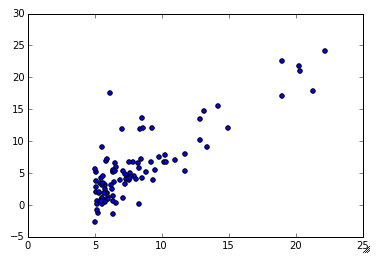
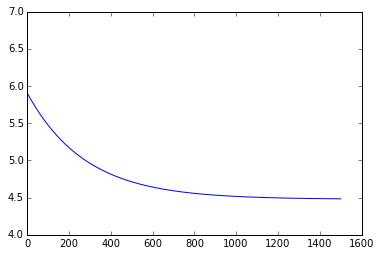
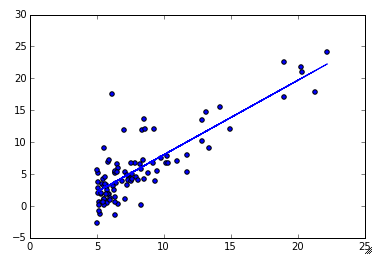

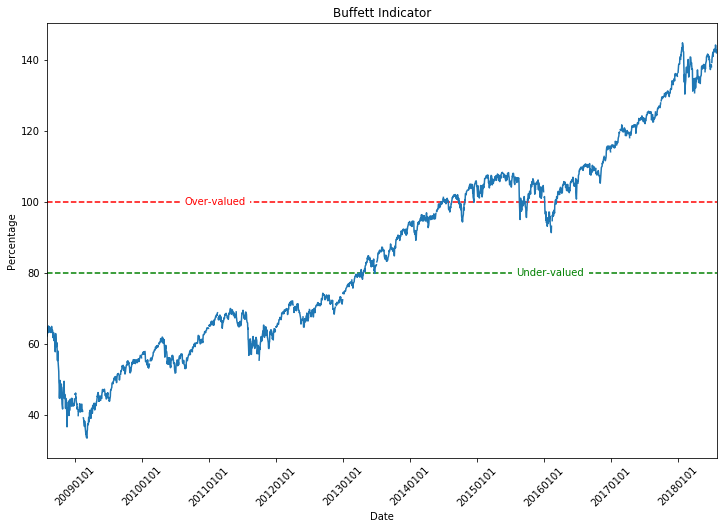
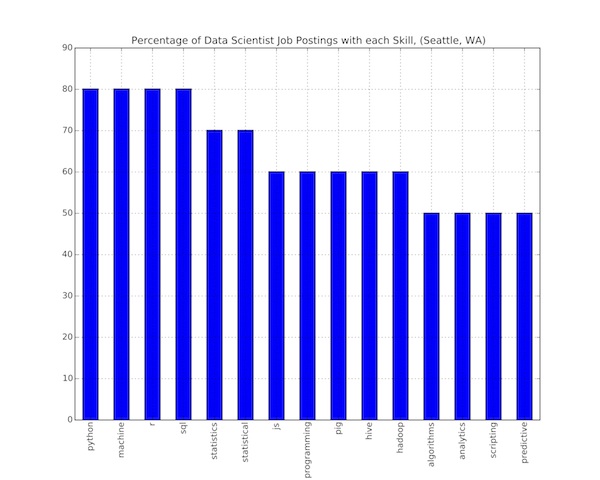


I really don't know how to express my thanks to you.